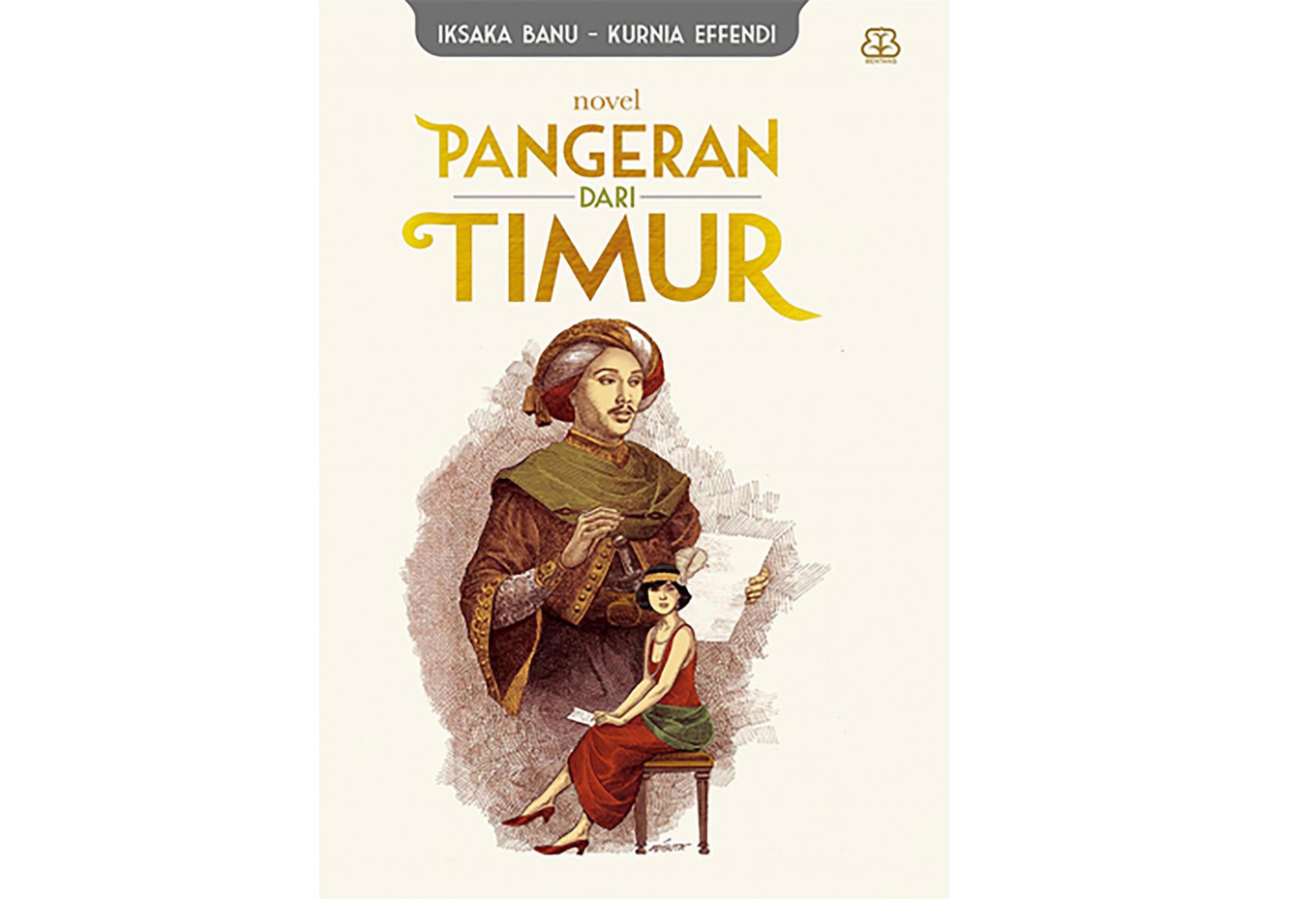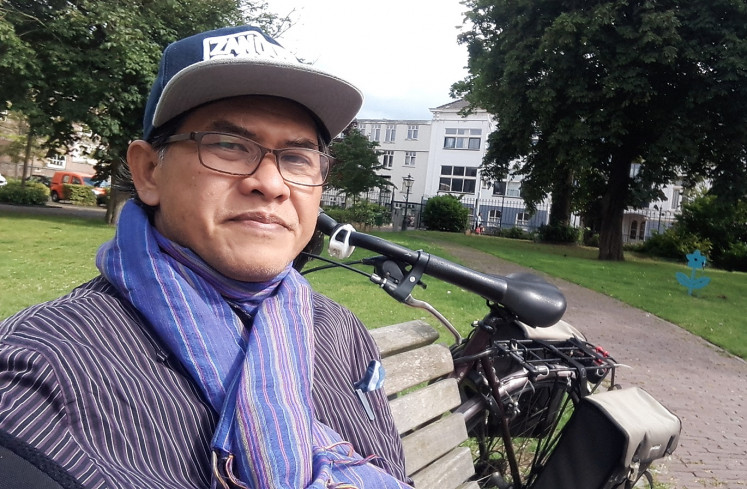Popular Reads
Top Results
Can't find what you're looking for?
View all search resultsPopular Reads
Top Results
Can't find what you're looking for?
View all search results‘Pangeran dari Timur’ chronicles the tragic life of Raden Saleh
Iksaka Banu and Kurnia Effendi’s new novel, Pangeran Dari Timur (The Prince from the East) chronicles the tragic yet vibrant life of Indonesia’s legendary painter, Raden Saleh.
Change text size
Gift Premium Articles
to Anyone
I
ndonesian authors Iksaka Banu and Kurnia Effendi have just launched a book they co-authored, a nearly 600-page historical novel called Pangeran Dari Timur that was more than 20 years in the making.
The double-plot novel that centers on the life of the great painter Raden Saleh (1811-1880) and the Indonesian intellectuals of the early 20th century is a tragic story of how colonialism and racism let Indonesia’s creative and intellectual minds down in the pre-independence era.
The life and death of Raden Saleh is the anchor of the dual narrative, beginning with his artistic talents and interests emerging as a child and through the eventual expansion of his artistic abilities under his Dutch mentor, Antoine Auguste Joseph Payen.
The artist then ultimately makes the decision to develop his skills and career in Europe, where he gains repute as a painter of the Romantic era. He produces commissioned portraits to earn an income while dedicating his free time to pursue independent projects, including those inspired by his observations of the animals in European circuses (like his real-life 1842 piece, Penunggang Kuda Arab Diterkam Singa/Arab Horseman Attacked by a Lion).
This is followed by the decline that started when the painter reached middle age. Upon his return to Indonesia, Raden Saleh feels the acute split between being a world-renowned painter and a pariah due to his skin color in colonial Indonesia, and the pain of being ostracized by his fellow Indonesians who perceive him as a Dutch ally.
Raden Saleh has been demystified in this novel, which also tells of his heart-breaking failed marriage to a Dutchwoman. The fictional work suggests the pair fell in love at the wrong time, when mixed-race marriages were still frowned upon.
On the master’s trail: Kurnia Effendi’s selfie shows the award-winning author in 2017 in the Netherlands, where he was researching the life of Indonesian master painter Raden Saleh for the double-plot novel he co-wrote with Iksaka Banu, 'Pangeran dari Timur' (The Prince from the East). (Courtesy of Kurnia Effendi/-)However, these are not the only tragic elements of the novel, which opens with the other plot that follows the lives of the three individuals trapped in a love triangle. Set during the infancy of the independence movement in the early 20th century, two Indonesians from privileged backgrounds meet at a party: Syamsudin, an architect who has his own firm and a connoisseur of the visual arts, and Ratna Juwita, who comes from a respected Indonesian-Dutch family.
Their stories become intertwined with Raden Saleh’s as Ratna, who is interested in knowing more about the visual arts, seeks out Syamsudin to learn about the master painter’s work and life. Syamsudin starts to develop special feelings for Ratna until Syafei, an associate at Syamsudin’s architecture firm, comes between them and changes everything.
The love affair adds some flavor to the fictionalized chronicle of life in early 20th century Indonesia. The most exciting element of this storyline is the two authors’ depictions of how vibrant and dynamic the community of privileged Indonesian intellectuals was at the time as they discussed not just politics, but also the arts. The community was, of course, also divided among their political views.
Syafei, a member of the (now defunct) Indonesian Communist Party, adopts a noncooperationist stance toward the Dutch colonists and believes that a violent revolution is the only route for Indonesians to rightfully “usurp” their independence.
The pragmatic and business-minded Syamsudin, however, believes that in doing business as equals with his Dutch clients, the architecture firm can hire more Indonesians and thus empower the people in paving their way to independence.
Obviously, the two eventually become polarized by their political views, notwithstanding the heightened emotionality brought on by their love triangle. Yet, each man’s passion and conviction for the path they are taking is equally inspiring, even if we might not necessarily agree with their views.
Their inspirational intellectuality and creativity is also what binds the 20th-century Indonesian characters with Raden Saleh.
Crafting history: Iksaka Banu, pictured in his home office, is a former advertisement executive who has written several award-winning titles prior to co-authoring 'Pangeran dari Timur' (The Prince from the East) with renowned author Kurnia Effendi. (JP/Sebastian Partogi)Along the way, the writers capture the great painter’s extraordinary creative reserves and how he gave them life. Again, despite the tragedy caused by the unjust and racist colonial system, we read in awe at how Raden Saleh’s creative instincts and endeavors serve as his source of resilience to get back up again from life’s myriad disappointments.
The fictional chronicle is also a kind of tribute to Raden Saleh, a cosmopolitan individual who spoke many languages. His circle of friends included prominent European authors and artists with whom he partook in animated conversations about current affairs in geopolitics and the arts.
Raden Saleh remains equally inspiring to Indonesians of this day and age who aspire to follow the same path in their own endeavors as artists, writers, journalists, activists and even politicians.
Although the novel can be hard to read at times, precisely because of its poignancy, those of us 21st-century Indonesians who read this work and strive to live a meaningful life as intellectuals and creatives can take the story as a cautionary message: We must not take our current freedoms for granted as we continue to develop our pursuits.(ste)
Pangeran Dari Timur
Iksaka Banu and Kurnia Effendi
Bentang Pustaka, 2020
593 pages













